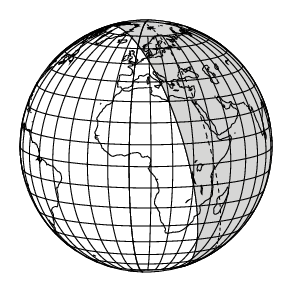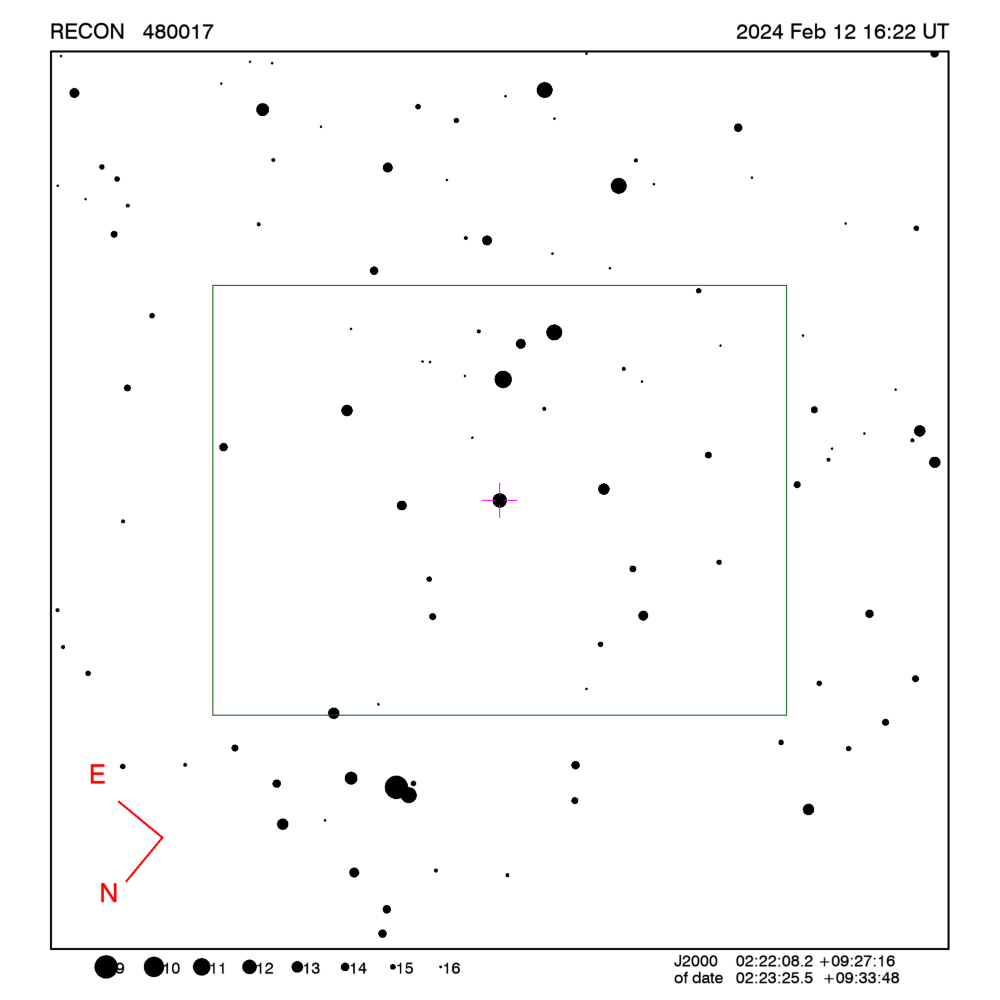RECON: TNO occultation with 480017
Event between (480017) 14QB442 and star GA0980:00202065
with event index number of 2317512
Geocentric closest approach at 2024/02/12 16:22:22 UTC
J2000 position of star is 02:22:08.2 +09:27:16
Equinox of date position of star is 02:23:18.1 +09:33:11
Stellar brightness G=12.3,
use SENSEUP=16 with the MallinCam and and exposure
time of 250 milli-seconds with the QHY174 camera.
Star is 35 degrees from the moon.
Moon is 11% illuminated.
TNO apparent brightness V=22.9
 TNO is 41.8 AU from the Sun
and 42.0 AU from the Earth.
TNO is 41.8 AU from the Sun
and 42.0 AU from the Earth.
The TNO is moving 13.9
km/sec on the sky relative to the star, or,
1.6 arcsec/hr.
The 1-sigma error in the time of the event is 174 seconds.
The 1-sigma cross-track error in the shadow position is
1796 km.
The TNO has an absolute magnitude Hv=6.5
Diameter=346.7 km assuming a 5% albedo -- 21.6 sec chord
Diameter=141.6 km assuming a 30% albedo -- 8.8 sec chord
Dynamical classification is SCATNEAR
Star training set for 480017, (2024/02/12 16:22UT)
Object RA Dec mag sep mel
Aldebaran 04:37:18.4 +16:33:21 0.8 33.30 68
Menkar 03:03:32.6 +04:10:59 2.5 11.31 44
24Xi Ari 02:26:06.8 +10:43:07 5.5 1.33 36
PPM 145516 02:22:39.3 +08:59:25 8.0 0.60 34
PPM 145517 02:22:45.6 +09:46:29 9.9 0.27 35
PPM 145522 02:23:13.2 +09:42:21 11.1 0.15 35
480017 02:23:25.5 +09:33:48 12.3 35
Positions are for equinox of date

Azimuth is measured in degrees eastward from north.
North is at an azimuth of 0, due East is at an azimuth
of 90 degrees, due South is 180, and due West is 270.
Do not use the listing below for the RECON CPC 1100 telescopes.
This is provided for other non-team facilities.
Star training set for 480017, (2024/02/12 16:22UT)
Object RA Dec mag sep mel
Aldebaran 04:35:55.3 +16:30:29 0.8 33.30 68
Menkar 03:02:16.8 +04:05:21 2.5 11.31 44
24Xi Ari 02:24:49.1 +10:36:38 5.5 1.33 36
PPM 145516 02:21:22.2 +08:52:52 8.0 0.60 34
PPM 145517 02:21:28.3 +09:39:56 9.9 0.27 35
PPM 145522 02:21:55.9 +09:35:48 11.1 0.15 35
480017 02:22:08.2 +09:27:16 12.3 35
Positions are for J2000
Event circumstances last updated at 2021/10/23 00:42:37 UT
Marc W. Buie,
Southwest Research Institute
RECON
 TNO is 41.8 AU from the Sun
and 42.0 AU from the Earth.
TNO is 41.8 AU from the Sun
and 42.0 AU from the Earth.
